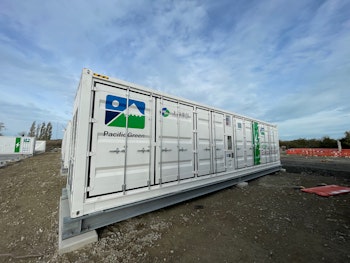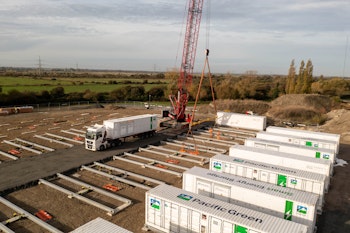
By Scott Poulter
The UK has long been an extremely attractive market for battery storage.
The island nation increasingly relies on highly variable offshore wind for its electricity and its limited interconnection capacity means there is a need for energy storage to balance out mismatches between supply and demand.
This need has allowed battery plants to flourish in the UK without the need for subsidies. Projects serve a variety of needs, from relieving substation congestion to providing ancillary grid services.
But one of the main indicators of battery demand is an annual Capacity Market auction held by a division of the National Grid Electricity System Operator called the Electricity Market Reform (EMR) Delivery Body.
The Capacity Market is one of the key policies of the EMR programme that was introduced following the UK’s Energy Act of 2013.
It aims to ensure the future security of the UK’s electricity supply, at the lowest cost to consumers, by providing a regular retainer payment to reliable forms of capacity in return for such capacity being available when the system is tight.
The Capacity Market auctions seek to retain capacity across two time horizons. The first, termed T-1, is for capacity that will be needed in the coming year. The second, T-4, is for capacity that the EMR Delivery Body believes will be needed in four years’ time.
This capacity can come in several forms. Traditionally, gas generation has taken the lion’s share of T-4 auctions and a more variable but still substantial amount of T-1 capacity.
Gas generation has the advantage of being very flexible but obviously involves a fossil fuel that contributes to global warming, making it less desirable as the UK moves towards a net-zero energy system.
The same goes for coal, which has had a variable presence in recent T-1 auctions but has been absent from T-4 contests in the last three years. Other important capacity market technologies in recent T-1 auctions include demand-side response assets and interconnectors.
Pumped hydro storage also has a constant presence in T-4 auctions, providing around 2.5 GW of de-rated capacity—that is, potential supply over and above peak demand—over the last half decade and 1.8 GW in the latest auction, in December 2022.
Then there is battery storage, which has been growing in importance in the last half decade. The 2020 T-1 auction, held in 2019, saw 50 MW of de-rated battery storage capacity being procured.
This rose to 140 MW in the 2021 T-1, then 510 MW in the 2022 T-1 and 880 MW in the most recent auction. Of this, 816 MW was from new-build projects, more than double the 380 MW from new battery plants in the previous T-1, according to EnAppSys, an energy system insight firm.

The amounts of battery storage being procured in the longer-term T-4 auctions are even greater. The 2023 T-4 auction saw 340 MW of de-rated battery capacity being prequalified and conditionally prequalified. In the 2024 T-4 auction this rose to 780 MW, then 1.39 GW in the 2025 T-4 round.
In 2022, 3.3 GW of de-rated battery capacity, equal to 14 GW in total, was prequalified and conditionally prequalified within the 2026 T-4 auction. This was despite 635 MW (or 137 MW after de-rating) of battery capacity being rejected, according to EnAppSys.
Most of the qualified capacity was for new-build projects, with only 302 MW of battery capacity(or 42 MW de-rated) from existing assets, EnAppSys said. Overall, said Fintan Devenney, an energy analyst at EnAppSys, "In the T-4 auction, prequalification results are broadly similar to last year's.”
Batteries and interconnectors “continue to hold a strong presence,” he said, “with Greenlink, the new Irish interconnector, prequalifying in its first ever application to a capacity market auction.”
Significantly, “More batteries have prequalified than ever before in a T-4 auction, with the majority of prequalifying assets being new builds," Devenney said.
In a December 2022 report, EnAppSys noted that in the previous T-1 auction, 93% of batteries that had prequalified on a conditional basis ended up bidding in the final auction.
“Overall, 66% more battery capacity has made it to this stage of the auction process than had done so by this point last year,” said the report.
“The increase in applications to the capacity market from batteries is influenced by the results from the previous year’s auction, in which the target capacity was greater than the total prequalified capacity,” it added.
This meant that every unit that was in the auction received a contract priced at the maximum possible clearing price. Looking ahead, there appears to be plenty of potential for battery storage in future auctions.
Gas has traditionally dominated the four-year-ahead auctions and still accounted for almost 33.6 GW of around 50 GW being procured in the 2026 T-4. This capacity will ultimately have to be phased out and there are constraints on the extent to which other technologies can take gas’s place.
Interconnectors, for example, have a fixed capacity and cannot be built or expanded at speed. Hydro, nuclear and pumped storage reserves also suffer from planning and construction challenges that could make scaling difficult.

All this is good news for investors looking to benefit from the UK’s growing battery energy storage market because it means demand for new assets will continue for some time. Plus, the Capacity Market is just one of several potential revenue sources for UK battery plants.
Battery plants can operate in several markets at the same time, which leads to revenue stacking—making profits from the delivery of multiple services using a single asset.
In the UK, Pacific Green Energy Storage is looking to maximise the value of this opportunity through the development of 1.1 GWh of battery energy storage projects, with an additional 500 MWh under exclusivity.
Our team has deep experience in developing and delivering large-scale electrical infrastructure in the UK, giving investors the opportunity to generated attractive long-term returns while helping to enable the country’s transition to a net-zero emissions energy system.
Publish date: 12 December, 2022